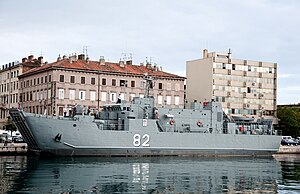 Krka (DBM-82) photographed in Rijeka on 17 September 2009 during the Croatian Navy day. | |
| Class overview | |
|---|---|
| Builders | Brodogradilište specijalnih objekata (BSO), Split |
| Built | 1980s–1994 |
| Completed | 3 |
| Active | 2 |
| General characteristics | |
| Length | 49.69 m (163 ft 0 in) |
| Beam | 10.2 m (33 ft 6 in) |
| Draft | 2.6 m (8 ft 6 in) |
| Propulsion |
|
| Speed | Maximum: 12.5 knots (23.2 km/h; 14.4 mph) |
| Range | 1,200–1,400 nmi (2,200–2,600 km; 1,400–1,600 mi) at 12 knots (22 km/h; 14 mph) |
| Endurance | 12 days |
| Complement | 32 |
| Armament |
|
The Silba class (sometimes the Cetina class) is a class of three landing ships, also used as minelayers, built for the Yugoslav (JRM) and Croatian Navy (HRM) during the 1980s and 1990s. The ships were built at the Brodogradilište specijalnih objekata shipyard in Split with slight differences in armament configuration between the last two ships. By the time the Croatian War of Independence started, one ship was in service with the JRM while another was being completed.
The one in JRM service was relocated to Montenegro where it would be commissioned with the Navy of the new FR Yugoslavia. The second ship that was captured unfinished was completed by Croatian forces and entered service with the HRM, followed by a third that was laid down by Croatia in 1993. The two ships commissioned with the HRM remain in active service, providing assistance to civilian institutions aside from their regular military tasks. The first ship in the class is currently decommissioned and in reserve in the Bay of Kotor, Montenegro.
